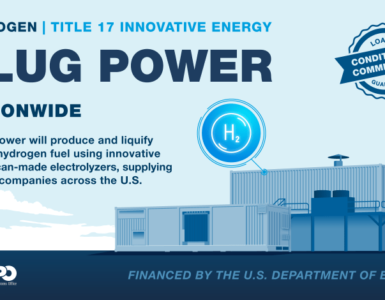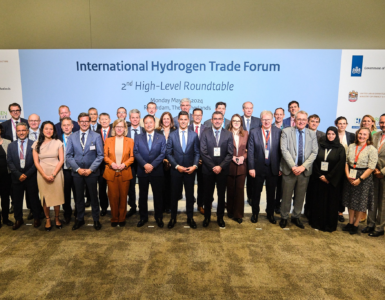Hydrogen Valleys: The Landscape of the Future.
[El Eonomista] Throughout history, countless dystopian representations have been made of how societies were going to be in the year 2040. Cars that fly, cities with unconventional architectures, new means of transport … The truth is that, more or less less removed from fiction, our societies will undoubtedly undergo changes in the coming years. We may not end up moving in flying cars but, for example, in vehicles powered by a new variety of fuels or new forms of energy that we did not imagine until now.The foundations of that society of the future are already being defined. And one of the great protagonists is undoubtedly going to be renewable hydrogen. Its relevance is evident in the fact that the European Commission last year presented a strategy on hydrogen that aims to channel up to 500,000 million euros into the infrastructure necessary for this gas to allow it to meet its goal of being emission neutral by 2050 Along the same lines, Spain has approved the Hydrogen Roadmap: a commitment to renewable hydrogen that includes 60 measures and sets a series of goals for 2030 such as reducing greenhouse gas emissions by 4.6 million tons CO2 equivalents or that at least one25% of hydrogen consumption by industry is renewable.
But why is this gas so relevant in the energy transition? If hydrogen has become exactly fashionable in recent years, it is because of the role it can play in the transition to a decarbonized economy . It does not emit CO2 when it is used, so that “it offers a solution to decarbonise industrial processes and economic sectors in which the reduction of carbon emissions is urgent and difficult to achieve”, as the European Commission (EC) explains.
🔥 What about we co-host a webinar? Let's educate, captivate, and convert the hydrogen economy!
Hydrogen Central is the global go-to online magazine for the hydrogen economy, we can help you host impactful webinars that become a global reference on your topic and are an evergreen source of leads. Click here to request more details
In Spain, we are also in luck. Our country has everything to get on the hydrogen train : “Spain has the opportunity to be a relevant player in the European energy sector that is being built around hydrogen. Undoubtedly, we have industrial, technological and climate capabilities , which we they provide that renewable resource necessary to be able to make hydrogen at a competitive cost. And the opportunity is there “, says Repsol’s Director of Hydrogen, Tomás Malango. In addition to the environmental and energy benefits, this gas generates a very powerful ecosystem and gives the opportunity to establish a value chain that goes from development and innovation to massive industrialization or commercialization, “which we have never had before,” he explains. the expert.
In our country there are already examples in this regard, such as the National Hydrogen Center of Puertollano. This La Mancha town is also home to the Castilla-la-Mancha hydrogen cluster , which is going to start up a photoelectrocatalysis plant in the area’s Repsol industrial complex . This new technology makes it possible to obtain renewable hydrogen using only rays of the sun, thus avoiding having to use electricity to produce it: its lower energy expenditure makes it more competitive and contributes to extending its different uses.

Tomás Malango:
The hydrogen valley is a concept that the European Union has developed to explain how the hydrogen economy is going to unfold , which will be in an initial local phase and based on an environment where there is a large production of hydrogen and several consumers.
“In the following stages, the plan is to deploy hydrogen throughout the entire value chain, first connecting the valleys and, finally, building hydrogen corridors that allow connecting valleys even in different countries.”
Given all this potential, in addition to Puertollano, other initiatives are emerging in the rest of Spain . For example, Repsol is developing its projects around three other valleys: the Basque Country, Catalonia and the Murcia Region , with the aim of producing 552 megawatts of this element by 2025 and 1.9 Gw in 2030. All this with “investments of the order of 2,500 million euros until 2030 “with a direct impact in two areas, employment and decarbonisation:” thousands of jobs will be created and more than a million tons of CO2 will be avoided, “Malango said.
“The renewable hydrogen produced in these valleys will be used in the short term for industrial uses but will gradually be incorporated into other fields such as mobility, ” explains Malango. And it is that hydrogen and its derivatives are, for example, keys to decarbonize this sector, especially in areas that are difficult to electrify, such as maritime, air and long-distance transportby highway. It can be used as a raw material, together with CO2, to produce synthetic fuels compatible with current combustion engines. And there are already some models of fuel cell electric vehicle (FCEV), which use hydrogen as a source of energy and could complement the battery electric vehicle, especially in heavy transport.
The great versatility of this gas for its energy uses and all its possible applications can reach between 10% and 20% of world energy consumption, once all its possible applications are deployed. “Hydrogen is going to join the palette of solutions for a decarbonized economy . We will have renewable gases such as biogas, hydrogen, liquid products derived from hydrogen, synthetic fuels or biofuels. It will be an exciting moment for the sector”, Malango concludes. Thanks for staying up to date with Hydrogen Central.
A whole world of possibilities in which our country has a lot to say and in which the common goal is clear: to advance in the decarbonization of the economy with new ways of understanding and producing energy that are already making a difference.
READ the latest news shaping the hydrogen market at Hydrogen Central
Hydrogen Valleys: The Landscape of the Future, El Economista








